Knowing the Facts of Breast Cancer
October 14, 2022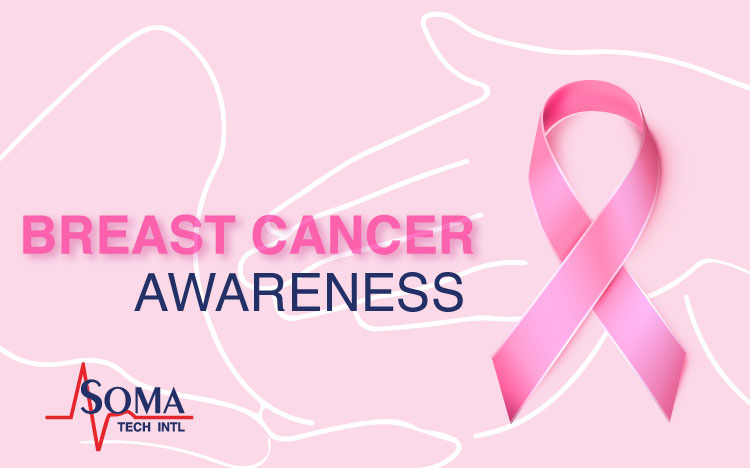
- Breast Cancer Awareness
- What is Breast Cancer?
- Symptoms and Signs of Breast Cancer
- Types of Breast Cancer
- Risk Factors
- Breast Self-Exam
- Mammogram Facts
- Final Thoughts
Breast Cancer Awareness
October has been recognized as breast cancer awareness month since 1985, when former First Lady, Betty Ford, was a breast cancer survivor herself. She wanted to launch a call to action to educate women about breast cancer and be able to talk openly about breast health.
What is Breast Cancer?
Cancer is a disease in which abnormal cells divide uncontrollably and destroy body tissue. The same happens with breast cancer, the only difference is that there are different types of breast cancer depending on what particular cells in the breast turn cancerous. It can begin in many different parts of the breast since it is made up of three main parts; lobules, ducts, and connective tissue. Breast cancer can also spread outside the breasts through blood vessels and lymph vessels.
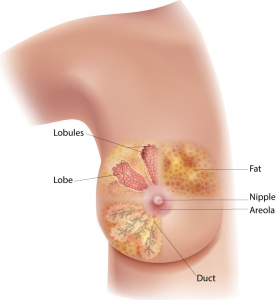
Symptoms and Signs of Breast Cancer
Cancer affects everyone differently and some cancers do not show symptoms until a professional screening is done. However, here are a few signs that can occur if breast cancer is present:
- Nipple tenderness or a lump near the breast or underarm area
- Change of texture or enlargement of pores in the breast skin
- A lump in the breast (all lumps should be seen by a medical professional) but not all are cancerous
- Change in size or shape of the breast
- Any dimpling on the breast
- Shrinkage of the breast (especially if only one is affected)
- Asymmetry of the breast that happened recently
- Inward or inverted nipple
- The skin of the breast, areola, or nipple that becomes scaly, red, or swollen
- Nipple discharge (clear and bloody are more concerning)
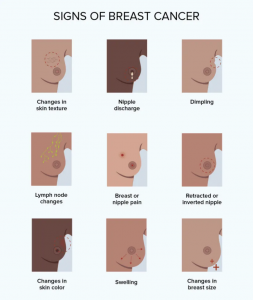
Types of Breast Cancer
- Ductal Carcinoma In Situ (DCIS): This is a noninvasive cancer that is found in the lining of the breast milk duct, but has not spread beyond that. This cancer is highly treatable if detected early.
- Invasive Ductal Carcinoma (IDC): This is an invasive cancer, where cells spread beyond the milk ducts and to surrounding breast tissue. This is the most common type of breast cancer, making up nearly 70-80% of all breast cancer diagnoses, including men.
- Lobular Carcinoma In Situ (LCIS): Abnormal cells are found in the lobules of the breasts, but have not spread beyond that. It is similar to DCIS, however, it just originates in a different place of the breast.
- Invasive Lobular Cancer (ILC): This is the second most common type of breast cancer. It starts in the lobules, also known as milk glands, and spreads to surrounding tissue. It can also spread through the blood and lymph systems.
- Triple Negative Breast Cancer: This type of cancer doesn’t have the three most common types of receptors that most breast cancers do and it is known to be more aggressive. Therefore, common treatments don’t work except for chemotherapy.
- Inflammatory Breast Cancer (IBC): This is aggressive and fast-growing breast cancer in the skin and lymph vessels of the breast. It can be hard to find because no symptoms show up until the lymph vessels are blocked by the cancer cells. It is usually classified as stage 3 breast cancer.
- Metastatic Breast Cancer: This is stage 4 breast cancer, at this point, cancer has begun spreading to other parts of the body. There are several ways that breast cancer cells can travel through the body and they usually spread to the lungs, liver, bones, or brain.
Risk Factors
While the cause of breast cancer is still unknown, genetics and environmental factors could play a big part. While most patients will not know what caused them to have breast cancer, there are risk factors associated with breast cancer to look out for.
Genetics:
- Gender: Breast cancer occurs in women a significant amount more than in men.
- Age: 2 out of 3 women with invasive cancer are diagnosed after 55.
- Race: Caucasian women have a higher chance of having breast cancer than other races.
- Obesity: A risk for both men and women.
- Family History: If an immediate family member has had breast cancer, your chances increase.
- Personal Health: If you’ve had breast cancer in the past, you are still at risk of breast or other cancers in the future.
- Menstrual and Reproductive History: Early menstruation, late menopause, and birth/no birth can also increase your risk depending on the woman.
- Genome Changes: Certain mutations in genes can also put you at risk.
- Dense Breast Tissue: This can make it harder to detect lumps and puts you at a higher chance of breast cancer.
Environmental Factors:
- Lack of Physical Activity: A sedentary lifestyle puts you at a higher risk.
- Poor Diet: Diets with a lot of saturated fat and lacking fruits and vegetables.
- Obesity: Being overweight can put you at a higher risk, especially if you have already gone through menopause.
- Alcohol Consumption: The more alcohol you consume, the greater the risk.
- Radiation: Radiation therapy on your chest before age 30 increases your chances.
- Combined Hormone Replacement Therapy: Taking HRT (used for menopause) can increase your chances that if breast cancer develops, then it will most likely be detected at a more advanced stage.
Breast Self-Exam
While breast cancer can’t be prevented, there are ways to help detect it early. Performing breast self-exams is key. Breast exams should be done at least once a month for women of all ages. Forty percent of diagnosed breast cancers are detected by women who feel a lump. There are 3 ways to perform a breast self-exam:
- In the Shower: With the flats of your 3 middle fingers, check the breast and armpit area by pressing down with light, medium, and firm pressure. You are feeling for a lump, thickening, hardened knot, or any breast changes.
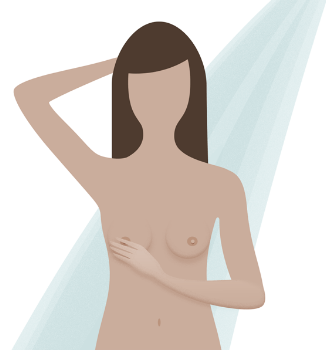
- In Front of a Mirror: Visually inspect your breast with both arms at your side and raised over your head. Look for changes in contour, swelling, dimpling of the skin, or changes in the nipple. You should also flex your chest muscles and look for differences in breasts, while most women’s breasts do not match perfectly, any big differences should be looked at.
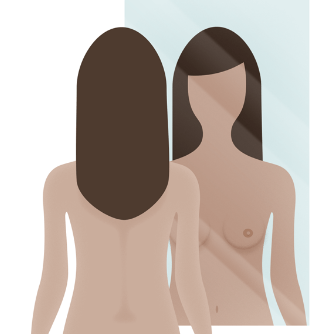
- Lying Down: When lying down, the breast tissue spreads out evenly. Place a pillow under your shoulder while raising your arm over your head. With the other arm, move the pads of your hands around the breast and armpit area with different pressures to look for any changes. You should also squeeze the nipple to check for any discharge or lumps. Then repeat to the remaining breast.
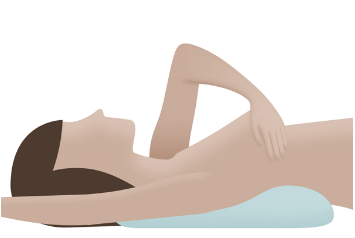
Mammogram Facts
While breast self-exams help, getting a mammography can tell you for certain if you have breast cancer. Mammography can detect tumors even before they can be felt. Your first screening is made at age 40 and it becomes continuous every year from then on. There are two kinds of mammograms to keep in mind. If you have no symptoms, a screening mammogram works best for your yearly mammogram. However, if you have continued pain, redness, lumps, or any other concerns, a diagnostic mammogram is better. Diagnostic mammograms are performed if there are irregular findings in a screening mammogram, as well. If you have concerns and are under 40, you might need a doctor’s referral to get a mammogram.
Final Thoughts
Did you know that 1 in 8 women will get breast cancer during her life? Breast cancer is a world health issue which is why October brings us together to raise awareness about breast cancer and breast cancer detection. Feel free to leave any comments and questions down below!
Explore Other Blog Items By Category
Recent Posts


Surgical Microscope Rentals

